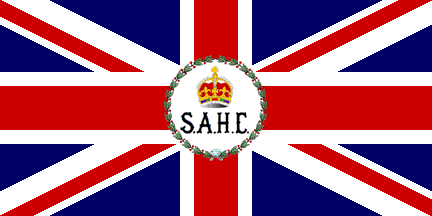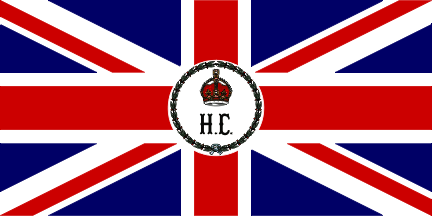 image by
Clay Moss, 18 Dec 2006
image by
Clay Moss, 18 Dec 2006
Last modified: 2019-01-01 by bruce berry
Keywords: lesotho | basutoland |
Links: FOTW homepage |
search |
disclaimer and copyright |
write us |
mirrors
 image by
Clay Moss, 18 Dec 2006
image by
Clay Moss, 18 Dec 2006
See also:
Prior to independence on 04 October 1966,
During the 19th century the remnants of various Sotho-speaking groups which had been torn apart by the Mfecane, a series of inter-African wars which affected much of southern Africa between about 1820 and 1830, came together under Moshoeshoe I. Using the mountains of Lesotho as a defensive fortress, Moshoeshoe was able consolidate a Sotho state.
The greatest threat in subsequent decades came from the Boers who trekked into Sotho territory after leaving the Cape Colony and created a rival state, the Orange Free State (OFS). Though the Sothos were initially able to contain the Boers, disputes over land led to wars in 1858 and 1865, which ended in the OFS possessing large tracts of land previously held by the Sotho. In order to stave off further Boer raids, Moshoeshoe successfully appealed for British protection in 1868. Basutoland was administered initially by the Cape Colony but after a Sotho rebellion in 1880-81, Britain assumed direct responsibly for the territory which became a protectorate in 1884 under direct rule by a Governor, though effective internal power was wielded by traditional chiefs.
Basutoland was administered through the Office of the High Commissioner in
The High Commissioner was also Governor of Basutoland and supervised the affairs of the Bechuanaland Protectorate (now Botswana) and Swaziland.
The High Commissioner in and for South Africa was
divided into the posts of Governor-General (of South Africa) and the High
Commissioner of Basutoland, Bechuanaland and Swaziland in 1931 and both posts had distinctive flags of their own.
Bruce Berry, 19 Feb 1998
Basutoland initially came under British
protection on 12 March 1868. In 1871 it was annexed to the
Cape Colony and later in 1884 it was returned to the
Crown as the Territory of Basutoland. Later it became a British Crown
Colony and finally a British Protectorate. Basutoland did not have a distinctive
colonial flag of its own and flew only the Union Jack as a national flag until
independence in October 1966.
Bruce Berry, 19 Feb 1998
 image by
Martin Grieve, 11 May 2003
image by
Martin Grieve, 11 May 2003
The High Commissioner flew a British Union Flag charged in the centre, on a white roundel, with the letters S.A.H.C. in black above which was a Tudor Crown, all within a green garland of laurel. This flag, which was taken into use in 1907, is similar in design to that of the Western Pacific High Commissioner.
This flag was used until 1931 after which the posts of
Governor-General (of South Africa) and
High Commissioner were separated.
Bruce Berry, 19 Feb 1998
 image by
Martin Grieve, 15 Nov 2005
image by
Martin Grieve, 15 Nov 2005
In 1931, the posts of High Commissioner of Basutoland, Bechuanaland and Swaziland and Governor-General of South Africa were created, the former being responsible for the administration of the British Protectorates in southern Africa.
The High Commissioner, based in
The High Commissioner flew a British Union Flag charged in the centre, on a
white roundel, with the letters H.C. in black, ensigned of the Imperial State
Crown proper, within a garland of green laurel. This flag was used until
Swaziland gained independence in 1968, the last of the High Commission
territories to do so.
Bruce Berry, 19 Feb 1998
 image by
Jaume Ollé, 08 Jun 1997
image by
Jaume Ollé, 08 Jun 1997
The High Commissioner, based in
The flag of the Resident Commissioner in Basutoland was the British Union
Flag charged in the centre, on a white roundel, with the shield of the
arms
granted to the Colony of Basutoland by Royal Warrant on 20 March 1951, namely:
"Vert, a crocodile proper and in chief a fleece between two garbs Or"
within a green garland of laurel. This flag was used in Basutoland
until it gained independence as the Kingdom of Lesotho on 04 October 1966.
Bruce Berry, 19 Feb 1998
![[Basutoland badge 1951-1966]](../images/l/ls)bas.jpg) image from
this website, located by Jarig Bakker, 18 Jun 2002
image from
this website, located by Jarig Bakker, 18 Jun 2002
This flag came in use after 20 March 1951 when the arms were granted.
Image according to Flag of All Nations (1955) [hms89a].
Perhaps the shield in a white circle was used unofficially in the blue ensign
because the image is shown in some plates according to "Banderas".
Jaume Ollé, 08 June 1997